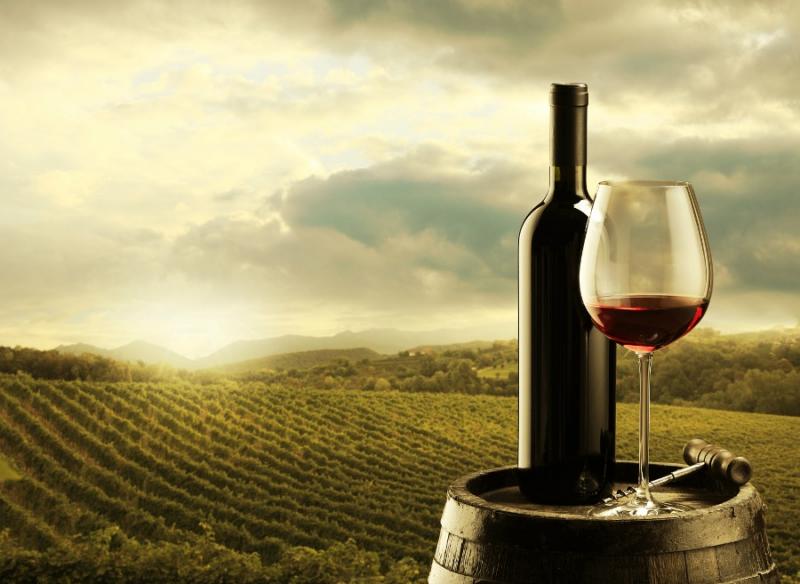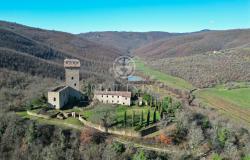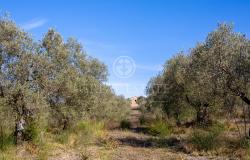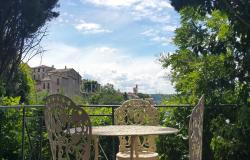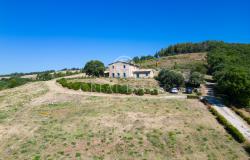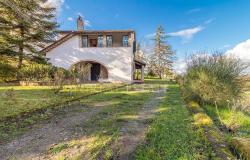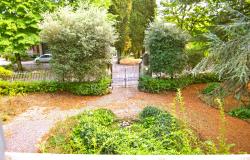Come to Umbria, the ‘green heart of Italy’, and you will discover an ancient wineland where vines still grow up trees and other living supports as they have done since the time of the Etruscans. Here indigenous grape varieties that exist nowhere else are still cultivated to result in truly outstanding and individual wines. Yet in contrast, state-of-the-art wineries are found alongside smallholdings where everything continues to be done come una volta – as it always has been.
Ancient Caves
Take Orvieto, Umbria’s best-known wine zone. The soft tufa mesa upon which this ancient city sits is riddled with a complex network of deep caves. These have served, from time immemorial, for the production and storage of wine. In some such caves today, you can still see the hand-carved stone channels down which the pressed grape mosto ran by gravity to the lower levels where it was gathered in terracotta fermentation vessels. Here, deep underground in a cool and constant temperature, first the Etruscans, then the Romans would slowly and steadily ferment the sugar-rich juice from grapes grown on the fertile volcanic soil of the surrounding countryside. The result, according to historical accounts, was a delightfully fragrant, slightly sweet wine (since the cool temperatures of the cave would often cause the fermentation to cease prematurely) that was probably far superior to many wines produced elsewhere.

Today, quite understandably, most of the large wineries have long since moved out of the old town to more convenient and modern (if less picturesque) premises on the lower plains and wine hills below the city. In the process, as elsewhere throughout Italy, they have installed stainless steel fermentation vessels and expensive refrigeration equipment to replicate the natural conditions of the ancient caves they abandoned. Are the wines better as a result? Certainly modern Orvieto is generally clean, consistent and well made, though in truth this is not a wine that will ever lay claim to absolute greatness. Come here all the same to sample a glass or two of the lightly sweet Orvieto amabile at outdoor tables by the Duomo.
Ones to Watch
Afterwards explore the surrounding wine country. As elsewhere in the region, some of the most exciting wines being made today are classified as IGT, sometimes made from international grape varieties such as Chardonnay and Sauvignon as well as from the characterful indigenous Grechetto. Red wines are increasingly being made here, too. The IGT classification "indicazione geografica tipica" often allows greater freedom in choice of grape variety and method of production and is increasingly used for some of Italy’s top wines. The Marchese Antinori’s Castello della Sala estate produces a superlative range of white wines, including the award-winning, mainly Chardonnay-based, Cervaro della Sala and the rare Muffato della Sala, made from grapes affected by noble rot. Other estates to watch include Barberani, Decugnano dei Barbi, Bigi, Tenuta Le Velette, and Palazzone.
Sagrantino… and Much More
Montefalco, located some 12km south of Foligno, is one of Umbria’s most interesting and exciting wine zones. Known as la ringhiera dell’Umbria – Umbria’s balcony – the medieval town is perched at a uniquely strategic point along the old Roman Via Flaminia that once linked the Tyrrhenian and Adriatic seas. Today, visitors who climb the belltower above the old Palazzo Comunale are rewarded with views over a sea of mixed countryside and rolling hills and valleys, stretching up to Foligno and beyond towards Assisi and Perugia.
Small winegrowers like the Bea family of the Antica Azienda Paolo Bea, who have been viticoltori in the zone for more than 500 years, continue to produce some of the most distinctive and individual wines of the zone. The Bea’s grow their grapes organically, and wines are meticulously selected and hand-produced. In recent decades, Montefalco has seen considerable investment in both vineyard and cantina, led by leading winemakers such as the outstanding and innovative Arnaldo Caprai. Other estates producing consistently high-quality wines include Rocca di Fabbri, Colpetrone and Antonelli.

As elsewhere in Umbria, the vine has been cultivated here for centuries if not millennia. The most distinctive variety is the indigenous Sagrantino which is capable of producing wines of immense individuality, character and personality. At best, whether dry or the sweet traditional passito version made from semi-dried grapes (Bea’s Montefalco Sagrantino passito is the outstanding example), this is a wholly uncompromising wine, raspingly high in tannin, with deep and intriguing scents and sometimes unusual, wild and funky flavours.
The Sagrantino grape, when not vinified in purezza, finds its way into the uvaggio of Rosso di Montefalco together with Sangiovese (primarily) and other grapes. But make no mistake, this is no minor little brother of Sagrantino: at best Rosso di Montefalco can be a serious, austere and big red in its own right as examples by Bea, Caprai and the Rocca di Fabbri demonstrate.
Meanwhile, the white Grechetto grape, used in Orvieto to add greater structure and depth of flavour, here is vinified as a 100% varietal to result in one of the best white wines of Central Italy. Caprai’s Grecante from the Colli Martani as well as Rocca di Fabbri’s Grechetto Colli Martani are two excellent examples.

A Family Affair
The small wine zone of Torgiano, some 10km to the south of Perugia, has probably done more than anywhere else to put quality Umbrian wine on the map. In the 1960s, Dr. Giorgio Lungarotti, a pioneering agronomist and viticulturalist, undertook to transform the centuries-old mixed agriculture of this corner of Central Italy into a dedicated specialised vineyard, planting both traditional grape varieties as well as those ‘new’ varieties that have since come to be widely planted throughout Italy, including Chardonnay, Pinot Grigio, Cabernet Sauvignon, Merlot and others. Today the legacy of the late Dr. Lungarotti continues under the guidance of his daughters Chiara and Teresa Severini. A fascinating and full range of wine is produced, from sparkling through young whites and vivid new wave reds (such as ‘Giubilante’) to traditional classics such as the flagship duo of white Torre di Giano ‘Vigna Il Pino’, and the consistently outstanding red Rubesco Riserva ‘Vigna Monticchio’.
In Umbria, a tour through its vineyards demonstrates that tradition and innovation quite happily co-exist: past, present and future of Italian winemaking.
Useful Links
- More news about Umbria
- The weather in Umbria.
- Map of Umbria
- Accommodation in Umbria
- Properties for Sale in Umbria
- Italian Language Schools in Umbria
